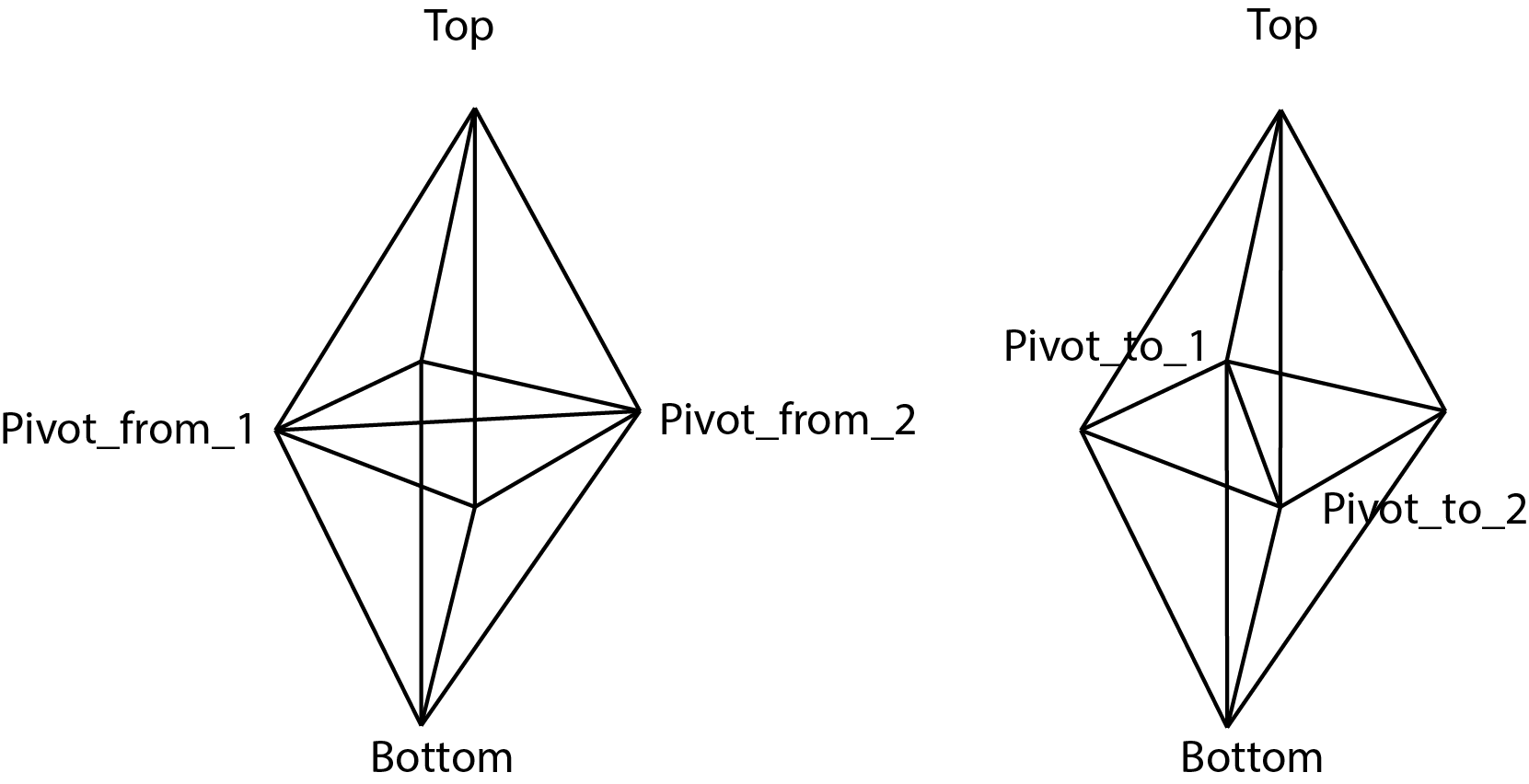Bistellar flip proposal for CGAL.
Uses the CGAL library to compute the bistellar flip of a given triangulation.
A bistellar flip operates on 4 cells in a 3-dimensional Triangulation_data_structure.
The pivot edge is the edge that is common to all 4 cells (obtained via a Circulator). It's endpoints are Pivot_from_1 and Pivot_from_2.
The new pivot edge is the edge that will be common to the 4 new cells. It's endpoints are Pivot_to_1 and Pivot_to_2, obtained by selecting the 2 vertices of the 6 comprising the 4-cell complex that are not the Top, Bottom, Pivot_from_1, or Pivot_from_2 vertices.
Here are the 4 old cells defined by the vertices labelled in the figure:
| Cell | Vertices |
|---|---|
| before_1 | Top, Pivot_from_1, Pivot_from_2, Pivot_to_1 |
| before_2 | Top, Pivot_from_1, Pivot_from_2, Pivot_to_2 |
| before_3 | Bottom, Pivot_from_1, Pivot_from_2, Pivot_to_1 |
| before_4 | Bottom, Pivot_from_1, Pivot_from_2, Pivot_to_2 |
We obtain these by querying vertex membership, e.g.:
if (cell->has_vertex(top))
{
if (cell->has_vertex(Pivot_to_1)) { before_1 = cell; }
else { before_2 = cell; }
}And here are the 4 new cells:
| Cell | Vertices |
|---|---|
| after_1 | Top, Pivot_from_1, Pivot_to_1, Pivot_to_2 |
| after_2 | Top, Pivot_from_2, Pivot_to_1, Pivot_to_2 |
| after_3 | Bottom, Pivot_from_1, Pivot_to_1, Pivot_to_2 |
| after_4 | Bottom, Pivot_from_2, Pivot_to_1, Pivot_to_2 |
Creating after_1:
Cell_handle after_1 = triangulation.tds().create_cell(top, Pivot_from_1, Pivot_to_1, Pivot_to_2);We also must obtain the neighbors of the 4 old cells, and assign them appropriately to the 4 new cells. CGAL indicates neighbors by a cell and the index of the vertex opposite the neighboring cell. The four cells form an octohedron, so there are 8 neighbors, as follows:
| Neighboring cell | Cell | Vertex opposite |
|---|---|---|
| n_1 | before_1 | Pivot_from_2 |
| n_2 | before_1 | Pivot_from_1 |
| n_3 | before_2 | Pivot_from_1 |
| n_4 | before_2 | Pivot_from_2 |
| n_5 | before_3 | Pivot_from_2 |
| n_6 | before_3 | Pivot_from_1 |
| n_7 | before_4 | Pivot_from_1 |
| n_8 | before_4 | Pivot_from_2 |
Obtaining n_1:
Cell_handle n_1 = before_1->neighbor(before_1->index(Pivot_from_2));We then assign neighbors to the 4 new cells:
| New cell | Neighboring cells |
|---|---|
| after_1 | n_1, n_4, after_2, after_3 |
| after_2 | n_2, n_3, after_1, after_4 |
| after_3 | n_5, n_8, after_1, after_4 |
| after_4 | n_6, n_7, after_2, after_3 |
Setting neighbors for after_1:
after_1->set_neighbors(n_1, n_4, after_2, after_3);And finally, assign the 8 neighbors back to the new cells:
| Neighboring cell | Cell | Vertex opposite |
|---|---|---|
| n_1 | after_1 | Pivot_to_2 |
| n_2 | after_2 | Pivot_to_2 |
| n_3 | after_2 | Pivot_to_1 |
| n_4 | after_1 | Pivot_to_1 |
| n_5 | after_3 | Pivot_to_2 |
| n_6 | after_4 | Pivot_to_2 |
| n_7 | after_4 | Pivot_to_1 |
| n_8 | after_3 | Pivot_to_1 |
Setting n_1 to its new neighbor after_1:
n_1->set_neighbor(n_1->index(triangulation.tds().mirror_vertex(
after_1, after_1->index(pivot_to_2))),
after_1);Where:
set_neighbor(int n, Cell_handle c)sets then-th neighbor of the cell tocindex(Vertex_handle v)returns the integer index ofvin the cellmirror_vertex(Cell_handle c, n)returns the vertex of then-th neighbor ofc
The assignment of neighbors to the new cells should complete the bistellar flip.
The last thing to do is to check that there are no orientation issues in the new cells. If there are, tds().reorient() is called on the triangulation (would be nice if this could be done on just the cell complex, but reorient is called on the entire triangulation, and is currently implemented in terms of the local function change_orientation, which does operate on individual cells and would be useful if exposed).
1. Obtain the pivot edge.
2. Obtain the 2 vertices comprising the pivot edge.
3. Obtain the 4 remaining vertices of the 6 vertices in the 4-cell complex.
4. Obtain the new pivot edge.
5. Obtain the 8 neighboring cells of the 4-cell complex.
6. Delete the old 4-cell complex.
7. Create the new 4-cell complex using the same 6 vertices.
8. Assign the 8 neighboring cells to the new 4-cell complex.
There are several helper functions which take a (Delaunay) triangulation as an argument, but would be probably be better implemented and exposed in the Triangulation_data_structure.
Returning ranges instead of containers would also be useful.
These functions return std::optional as a result is not necessarily guaranteed:
It might be useful to return as std::expected<T,E> whenever that is widely available.
